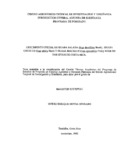| dc.contributor.advisor | Kass, Donald | es_Es |
| dc.contributor.author | Novoa Serrano, O.E. | |
| dc.date.accessioned | 2014-10-17T06:58:36Z | |
| dc.date.available | 2014-10-17T06:58:36Z | |
| dc.date.issued | 1992 | es_ES |
| dc.identifier | 342062 | es_ES |
| dc.identifier.uri | https://repositorio.catie.ac.cr/handle/11554/1023 | |
| dc.description | Tesis (M. Sc) -- CATIE, Turrialba (Costa Rica), 1992 | es_ES |
| dc.description.abstract | El género Inga Mille es ampliamente utilizado en diferentes sistemas agroforestales desde México hasta el norte argentino, donde se distribuye naturalmente y se sabe preliminarmente que existen diferencias estructurales y de crecimiento significativas, dependiendo del lugar donde esté. La presente investigación tiene como propósito medir diferencias en crecimiento libre inicial de las especies de guaba salada o caite (Inga densiflora Benth), guaba chilillo o mecate (Inga edulis Mart) y guaba machete o guaba de costa (Inga spectabilis (Vahl) Willd) a los tres y seis meses de establecida la plantación, en dos sitios de Costa Rica: San Isidro del General y Turrialba (Finca Experimemtal CATIE). Las variables evaluadas fueron: altura total, presencia de ejes o ramas, diámetro basal y diámetro de copa. El análisis se hizo por familia dentro de especie y, a su vez, especies dentro de sitio. El desarrollo mostrado por la plantación en Finca UNA (San Isidro) fue mayor al del sitio Puente Cajón (CATIE), en términos generales. Pero el incremento en crecimiento (entre una época de medición y otra) lo tuvo Puente Cajón con respecto a Finca UNA. Los resultados indicaron que, desde la primera medición, las tres especies mostraron diferencias significativas con respecto a las variables evaluadas, siendo edulis la que mostró el mejor desarrollo e incremento. También dentro de cada especie se logró detectar diferencias significativas a nivel de familia. La presente investigación logró encontrar a los seis meses de establecidas ambas plantaciones correlaciones de crecimiento altamente significativas entre las variables diámetro de copa con altura total diámetro de copa con diámetro basal número de ejes con diámetro de copa y altura total con diámetro de copa. Este estudio de comportamiento de crecimiento debe establecerse en otras zonas donde se logre discriminar cuales familias de las especies de Inga spp en estudio pueden ser potencialmente utilizables dentro de sistemas agroforestales de las zonas en evaluación. Lo ideal sería que se evaluaran en zonas de vida más secas donde las tres especies en estudio son utilizadas dentro de sistemas de Producción agroforestal y poder verificar su comportamiento ante diferentes situaciones ambientales. | es_ES |
| dc.description.abstract | The genus Inga Mille is widely used in different agroforestry systems from Mexico to northern Argentina, where it is naturally distributed and it is preliminarily known that there are significant structural and growth differences, depending on the location. The purpose of this research is to measure differences in initial free growth of the species of guaba salada or caite (Inga densiflora Benth), guaba chilillo or mecate (Inga edulis Mart) and guaba machete or guaba de costa (Inga spectabilis (Vahl) Willd) three and six months after plantation establishment, in two sites in Costa Rica: San Isidro del General and Turrialba (Finca Experimemtal CATIE). The variables evaluated were: total height, presence of axes or branches, basal diameter and crown diameter. The analysis was done by family within species and, in turn, species within site. The development shown by the plantation at Finca UNA (San Isidro) was greater than that of the Puente Cajón site (CATIE), in general terms. However, the greatest increase in growth (between one time of measurement and another) was at Puente Cajón with respect to Finca UNA. The results indicated that, from the first measurement, the three species showed significant differences with respect to the variables evaluated, being edulis the one that showed the best development and increase. Significant differences were also detected within each species at the family level. The present investigation was able to find highly significant growth correlations between the variables crown diameter with total height, crown diameter with basal diameter, number of axes with crown diameter and total height with crown diameter six months after the establishment of both plantations. This study of growth behavior should be established in other areas where it is possible to discriminate which families of the Inga spp. species under study can be potentially usable in agroforestry systems in the areas under evaluation. Ideally, they should be evaluated in drier life zones where the three species under study are used in agroforestry production systems and their behavior in different environmental situations could be verified. | en |
| dc.language.iso | es | es_ES |
| dc.publisher | CATIE, Turrialba (Costa Rica) | es_ES |
| dc.subject | COSTA RICA | |
| dc.subject | CRECIMIENTO | |
| dc.subject | DIAMETRO | |
| dc.subject | DIMENSION | |
| dc.subject | MEDICION | |
| dc.subject | ETAPAS DE DESARROLLO DE LA PLANTA | |
| dc.subject | AGROFORESTERIA | |
| dc.title | Crecimiento inicial de Guaba salada (Inga densiflora Benth), Guaba chilillo (Inga edulis Mart) y Guaba machete (Inga spectabilis (Vahl) Willd) en dos sitios de Costa Rica | es_ES |
| dc.type | Tesis de maestría | es_ES |
| dc.identifier.publication | Turrialba (Costa Rica) | es_ES |


